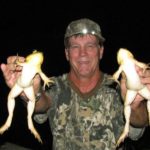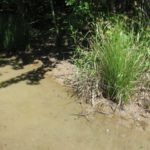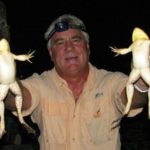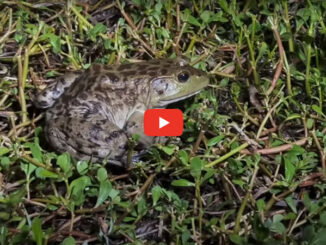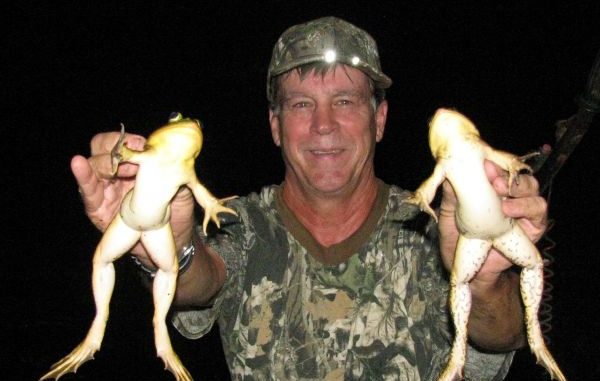
If the west winds blow the water out of your favorite fishing hole, just wait for darkness to settle on the swamps near Manchac and paddle out for some hectic frogging. Here’s how to make the most of the opportunity.
“Wind from the WEST!” Artie yelled, waving his arms crazily and looking around. “Fish bite BEST! Who on earth came up with DAT?”
He pointed at the flapping Saints flag on the porch of Doc’s camp as he yelled.
“Whoever it was sure didn’t live in Southeast Louisiana!” Eddie answered, pointing at the exposed mud stretching about 2 feet from the edge of the spartina grass to the muddy canal right below us. “Gonna be a skimpy Father’s Day fish fry!”
“Man, we can’t seem to get a break lately,” Doc added, as he dumped another pile of steaming crawfish on the table. “Same pattern every June for the past few years, it seems: super-low tides from west winds coupled with super-high Mississippi and Pearl rivers. Dat sure ain’t what we need right now for our speck fishing.”
“Sure ain’t!” Artie moaned. “Perfect combo for fresh and dirty waaaw-dah in our Southeast Loooziana coastal marshes!”
“Oh well — at least the high rivers means we can still get some good Belle River crawfish,” Doc said, crushing and loudly slurping on the head of a big mud bug. “Shells ain’t even that hard yet.”
“What’s all the bellyaching about?” Pelayo asked as he plodded up the back stairs lugging two grocery bags after a wine run for the gals. “Told ya I wouldn’t need to go far. Shoot, man: Seems like nowadays all the Time-Savers carry a bigger wine selection than Schwegmann’s EVER had.”
“TIME –SAVERS?!” Priscilla laughed. “Where’d you find a TIME-SAVER?”
“Yeah, dey ain’t dere no more,” Artie cackled as he wound up and pitched his crawfish head into the canal. “In fact, dey ain’t been there FOR YEARS!”
The gang quickly joined in jeering and cackling.
Pelayo stopped, looked around and ceremonially put down the grocery bags. He got everyone’s attention with a loud clap, and then he started drumming on the veranda, tapping out the unmistakable beat from one of our favorite Billy Joel songs — one that had thumped out from Doc’s state-of-the-art and much-appreciated (except by his neighbors) sound system not an hour earlier.
“What’s the matter with the stores I’m shopping? Can’t you tell that they’re out of style?”
Vince Vance had nothing on Pelayo’s stage presence, as we all started nodding and foot-tapping.
“Everybody’s talkin’ ’bout these Circle- K stores — BUT THEY’RE STILL TIME-SAVERS TO ME!”
The thunderous ovation and whooping had just subsided when Pelayo took a bow and asked for quiet again.
“Shoot man!” he yelled. “In fact, I say we’re gonna have one of the tastiest Father’s Day fish frys in years!”
Some of the gang started frowning again.
“OK,” Pelayo nodded, acknowledging the frowns. “Given the lousy fishing conditions — sure, the fried speck fillets may not be piled as high as usual.
“But can I get y’all a side order of FRESH FROG LEGS!”
Most of the gang still seemed confused, so Pelayo pressed ahead.
“Well, dat’s what I’m planning for the Father’s Day fish fry, ya follow me?” he said. “When life hands you west winds and low tides, GO FROGGING!
“Or have you guys forgotten?”
Artie, Doc and I looked at each other wide-eyed and nodding.
INDEED! Pelayo hit upon a fabulous idea. Our type of frogging, you see, was always the low-budget, seat-of-the-pants type. No airboats, no surface drives — not even any outboards.
We traditionally did our frogging from our duck-hunting pirogues. And in an area where “’rouges” are all you need.
In our Tiger Land years, we called it “da Manchac swamp.” Now it’s better known as the Maurepas Swamp WMA — basically the wetlands bordering the old Highway 51 from Laplace to Pass Manchac.
We’d park on Highway 51, slip our ’rouges from the truck and into one of the innumerable little sloughs marked by culverts under the highway, and paddle (usually west) into the swamp, scanning the bank, dodging the alligators and always gigging up a mess of bull and pig frogs.
It doesn’t get much easier than this.
For this type of frogging you WANT low tides. High tides means the frogs scatter into the flooded overflow swamp.
Getting to them under high-water conditions certainly requires an airboat.
But on a low tide, many frogs tend to perch on that exposed mud bank between the alligator grass and the edge of the slough, making them easy picking for ’rouge-bound froggers.
Again: It don’t get much easier than this!
We had one warm but windy night to get these fixin’s. So off we went.
The wind — still westerly — helped in another respect: It kept the bugs so attracted to our head lamps somewhat at bay.
Pelayo and I manned his 14-foot two-man ’rouge, while Artie took his 12-foot round-bottomed one-seat boat.
The plan was for each pirogue to concentrate on one bank of the slough. Then we’d switch banks on the way out. This way we wouldn’t miss any frogs.
Similar to deer, bullfrogs and pig frogs seem to thrive best in areas with thick understory.
Obviously we’re not referring to the greenbriar, muscadine, Chinese privet, blackberry, honeysuckle, gallberry, etc. that so often characterizes good deer habitat. For frogs, “understory” refers to alligator grass, coastal water-hyssop, smartweed, duck potato, iris, peavine, etc. that grows thick and lush in most of the Maurepas Swamp — especially the wetter, more-open areas.
In our experience, the bayou, canal and slough banks with a closed canopy of trees overhead, and thus sparse weeds near the bank, harbor many fewer frogs than more-open ones that allow the sun to penetrate and the undergrowth to flourish.
But again: You want a low tide so they’ll be out of that foliage and accessible.
In a nutshell, our favorite frogging locales and conditions can be easily defined as bayous, pond and canal banks with heavy shoreline brush during low tides.
This is why we prefer the upper reaches of the Maurepas swamp— roughly the stretch between Shell-Bank Bayou just below the Ruddock public launch up to Pass Manchac — for this venture.
This area is characterized by a more-open canopy of dead, studded cypress and tupelo trees.
Launching the ’rouges near Shell Bank Bayou proved quicker and easier than launching a bass boat at Ruddock or North Pass — no crowds!
Though the main 51 Canal bordering I-55 usually holds a few frogs, the main action comes — as mentioned — by getting into the sloughs flowing westward into the interior of this cypress-tupelo overflow swamp.
Ah, YES!
If there’s anything more enchanting than a South Louisiana swamp panorama, it’s a South Louisiana swamp panorama at night.
The first scan of our head lamps along the slough revealed dozens of eyes glowing back.
“Won’t take us long to load the basket tonight!” Artie whooped nearby.
“How quickly you forget!” Pelayo laughed. “That’s mostly gators. You know — that endangered species.”
“RIGHT!” Artie laughed back. “About as endangered as red snapper!”
“And that’s a nutria,” I added, pointing to some glowing eyes in front. “Frog eyes glow green. The other swamp critters have eyes that glow in pink or red.
“The little green ones belong to little tree frogs and spiders. Remember?”
It had been a few years since we’d partaken of this activity that was routine for us during our Tiger Land years. Now it was all coming back, and we wondered why we’d been away from something so easy and fun for so long.
Ah!” Artie yelled. “Hear him?”
“Dat’s a PIG frog,” Pelayo again corrected. “A few short grunts — like a pig. Bullfrogs let fly with those longer, drawn-out groans.
“How quickly you forget, Artie! First the eyes. Now the grunts!”
A big bullfrog’s green eyes and white chin glowed up ahead. It was sitting half submerged in a bed of floating alligator-grass.
“Wont need a gig for this one,” Pelayo said as we softly paddled toward, the prey — then we simply drifted, drift ….
And Pelayo reached down and grabbed it.
“Abra-abra-cadabra!” he laughed as he held up the frog. “I wanna reach out and grab ya!”
In seconds, the frog was hopping crazily in a wire basket.
“Knew we’d forget something!” Artie laughed from across the slough. “The sound system! Got Steve Miller’s greatest hits CD in my truck!”
“Whoops!” Artie pointed ahead as his head lamp illuminated another of our quarry.
Another nice bullfrog, although it was a bit obscured by branches.
So Artie started extending his gig — but bump, the gig hit a branch while en route.
Plop!
The frog was gone.
Frogs in this area like perching near the bottom of the wax myrtles and bachiris bushes overhanging the water. This makes it important to attach a LONG pole (12 feet for us) on the gig to get at them.
But be careful not to bump any branches along the way.
Scanning and gigging the next 300 yards of bayou bank yielded us six more frogs: four pigs and two bulls.
Then we turned into a shallow slough, and eyes glowed ahead — but these were mostly green.
“Whoo-boy!” Artie yelled.
We ended up with 18 frogs: seven pigs and 11 bulls.
A joke by Atchafalaya Basin standards, but a great (and easy and economical) frogging trip by ours.
